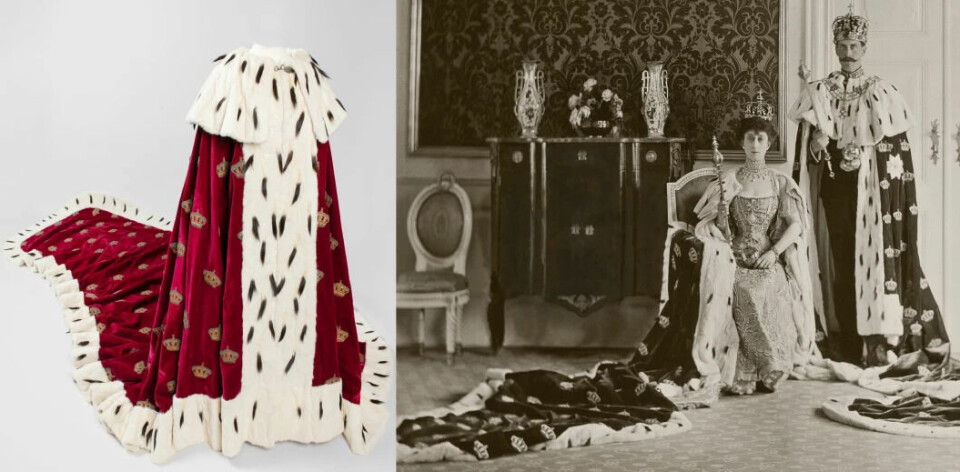
Three women became Norwegian queens in this robe. Maud was the last one
Right after the coronation of King Haakon and Queen Maud, the Norwegian Parliament decided to stop the practice of coronations. Maud’s coronation robe is now displayed in Queen Sonja’s Art Stable.
The old stable in the corner of the Palace Park in Oslo was transformed into Queen Sonja’s Art Stable six years ago. The first thing you see when you enter is a magnificent robe made of dark red velvet and fur, with sewn-on silver crowns.
It has been worn by three Norwegian queens. It should have been four.
The cape was made for Queen Joséphine when she and Oscar I were to be crowned in Norway in the mid-1800s.
“But they were still not crowned in Norway, only in Sweden,” Sandra Lorentzen says. She is a curator and chose the queen's robe when sciencenorway.no asked about the best item the Art Stable has to offer.
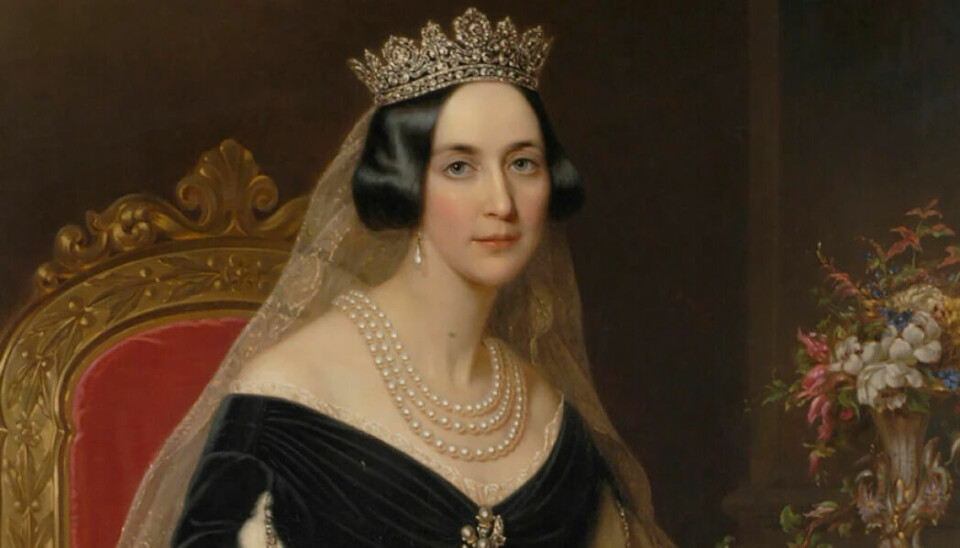
Did not want to crown a Catholic
Joséphine was both a duchess and a princess in Italy. Therefore, she was a good match for the Swedish-Norwegian royal house, which needed legitimacy after a French officer was elected king a few years earlier.
But Joséphine was Catholic. She had been promised religious freedom in Norway-Sweden, but the Norwegian bishop in Nidaros did not want to crown a Catholic queen, according to royalcourt.no. As a result, she never got to wear her newly made coronation robe.
The robe is now on display along with other items from the Royal Palace. Most of them are still in use but are now on loan to the Art Stable.
“We have chosen to highlight the craftsmen who made what we exhibit. Many of these professions are dying out or are worthy of conservation,” Lorentzen says.
Ancient craftsmanship
Furrier’s trade is one such craft. It involves designing and sewing garments made of fur. In the past, furrier was a common profession in Norway, but today there are only five fur workshops left, according to snl.no (link in Norwegian).
“Furrier’s trade is an ancient craft that dates back to the Stone Age. People dressed in animal skins to face all kinds of weather,” Lorentzen says.
Today, we have stopped wearing fur, and fur farming was banned in 2019.
“Furrier’s trade is a dying profession, but they still repair existing coats,” she says.
It was the Swedish furrier Frans Willibald Hellbacker who made the queen's coronation robe.
1,500 stoats were used
“We don't know much about him, but he made all the Swedish and Norwegian coronation robes. Presumably, he had some kind of royal warrant,” Lorentzen says.
It took 1,500 Siberian stoats to make the ermine fur on the collar, along the front, and on the underside of the train.
Underneath the fur robe, the queens wore a dress, while the kings wore uniforms.
“When I saw the coronation of King Charles in England, I thought it must have been very hot for him with all those layers,” she says.
The first to wear the queen's coronation robe was Queen Louise.
First queen crowned since Euphemia in 1299
She and Charles IV were first crowned in Sweden and then in Nidaros Cathedral in Norway in 1860.
At that time, 560 years had passed since the last queen was crowned in Norway. It was Queen Eufemia, together with King Haakon V Magnusson, in 1299.

Louise was a member of the royal family in the Netherlands. The royal connection, along with a substantial dowry, made her a suitable match for Charles.
Before the coronation, Louise traveled around Norway. In the king's speech at the coronation dinner, he said that she had visited places where no queen had been before, according to a book about the royal couple from 1873.
The same book offers an explanation of why Louise is not so well-known today: "We shall be brief about Queen Louise. It is in the nature of things that a woman, in general, does not appear as prominently in public events. She ... never sought to play any prominent role in life."
But she is said to have kept a close eye on politics, in addition to enduring her husband's notorious infidelity, according to snl.no (link in Norwegian).
Queen and political adviser
King Charles IV died 12 years after the coronation in Trondheim, only 46 years old. His brother, Oscar II, took over the Swedish-Norwegian throne.
His wife, Queen Sophia, thus became the next to wear the queen's coronation robe in Nidaros Cathedral in 1873.
Sophia was led into Nidaros Cathedral by a large entourage with the Prime Minister at the forefront. "She was very pale and not very well-adapted," according to Anne-Marie Riiber's book about Queen Sophia. But the procession was magnificent.
The queen was dressed in a white satin dress with fringes and silver cords. It matched the crowns on the robe. The train was carried by employees at the court. The queen was "very moved" during the three-hour ceremony.
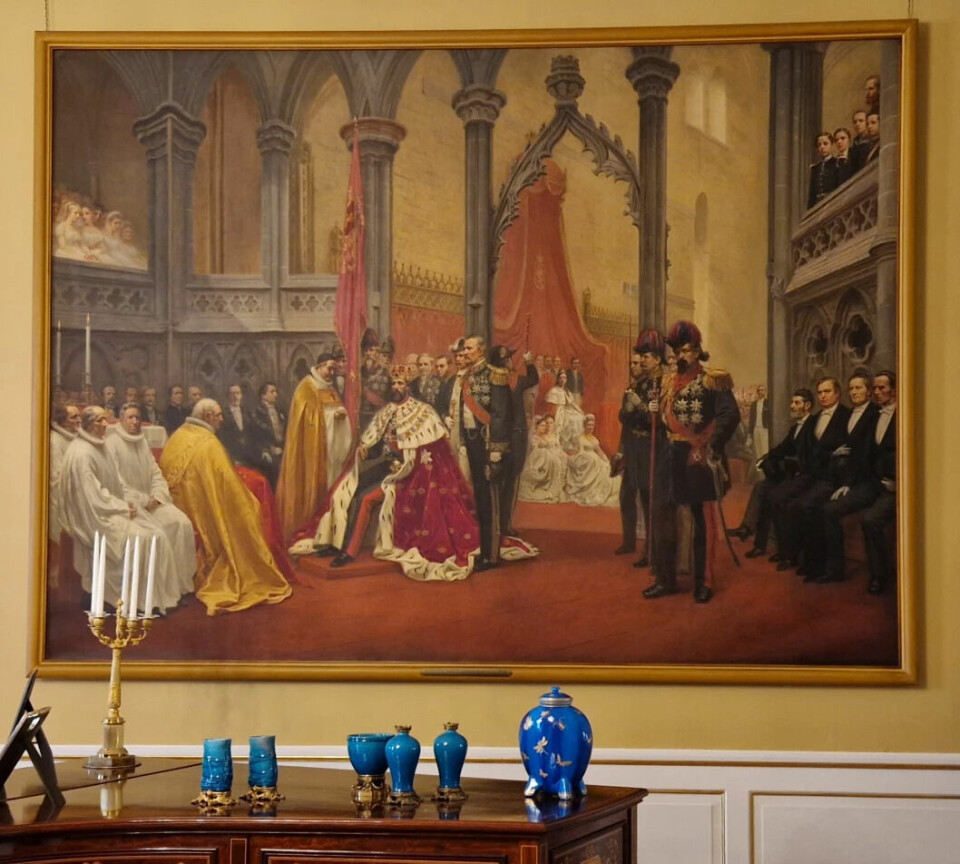
Sophia came from an ancient noble lineage in Germany and had four sons with Oscar II. She is the great-grandmother of our King Harald.
Sophia was politically interested, her husband's adviser, and read up to 20 newspapers a day, according to snl.no (link in Norwegian). And she often visited Norway, sometimes for extended periods.
She became the last Norwegian-Swedish queen.
Subdued coronation in the new Norway
King Oscar II was constantly in conflict with the Norwegian Parliament (Storting), which was no longer satisfied with a subordinate role in the Swedish-Norwegian union. In case after case, he vetoed more Norwegian independence. Finally, in 1905, the Storting passed a resolution declaring the union dissolved. Oscar II saw it as a personal defeat, according to snl.no (link in Norwegian).
In 1905, the Danish Prince Carl was elected king of independent Norway. He took the name Haakon VII and was crowned the following year in Nidaros Cathedral, together with Queen Maud.
It was not a foregone conclusion. Many believed that coronations were outdated and undemocratic. Therefore, the coronation was toned down, according to royalcourt.no. However, the robes were kept.
The painting of Haakon and Maud's coronation differs from the two other coronation paintings hanging in the Royal Palace.
The queen in the centre
Queen Louise and Sophia are peripheral in the paintings of their coronations; you almost have to search to find them. The kings have the central position.
In the coronation painting of Haakon and Maud, the focus is on the queen, while the king is placed to the side. This is probably not accidental, according to Sandra Lorentzen.
Although the people had voted for continued monarchy, and Haakon had been chosen as king, Maud was of great significance.
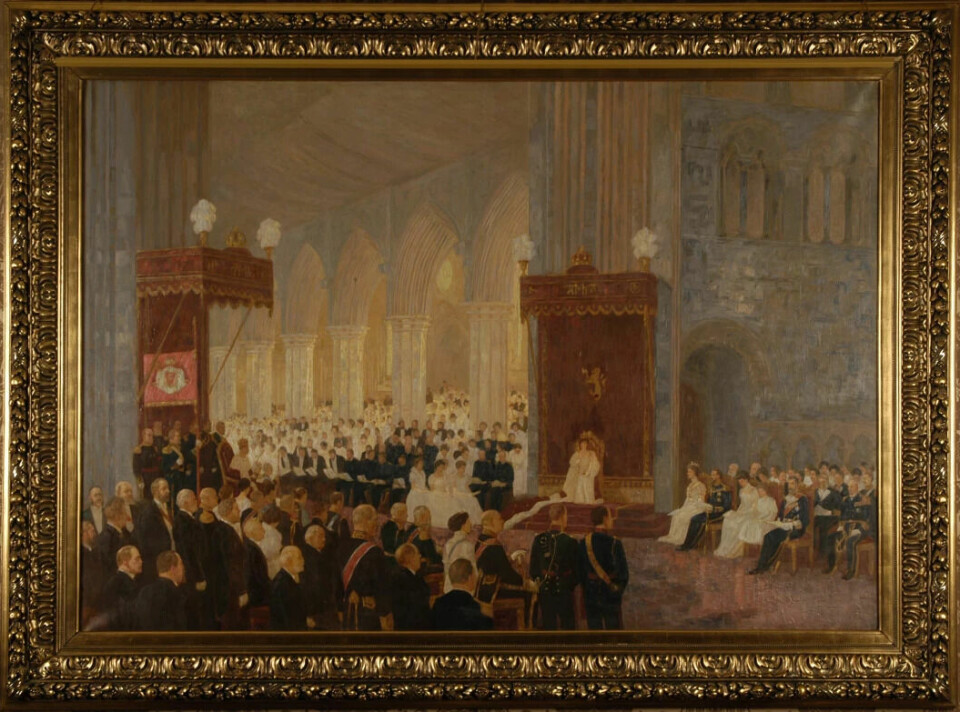
“Maud was a princess in the powerful British Empire. They also had a son, Crown Prince Olav, so the line of succession was secure. There was probably a lot of symbolism in presenting the queen in that way,” Lorentzen says.
The coronation paintings are also historical documents. We can see the restoration of Nidaros Cathedral, which guests were present, and the coronation itself. The curators at the Art Stable can learn about the queen's coronation robe.
“Although they document history, they are just as much works of art. Artists can take liberties. Queen Sophia's robe collar has three rows of ermine; that's probably not accurate,” she says.
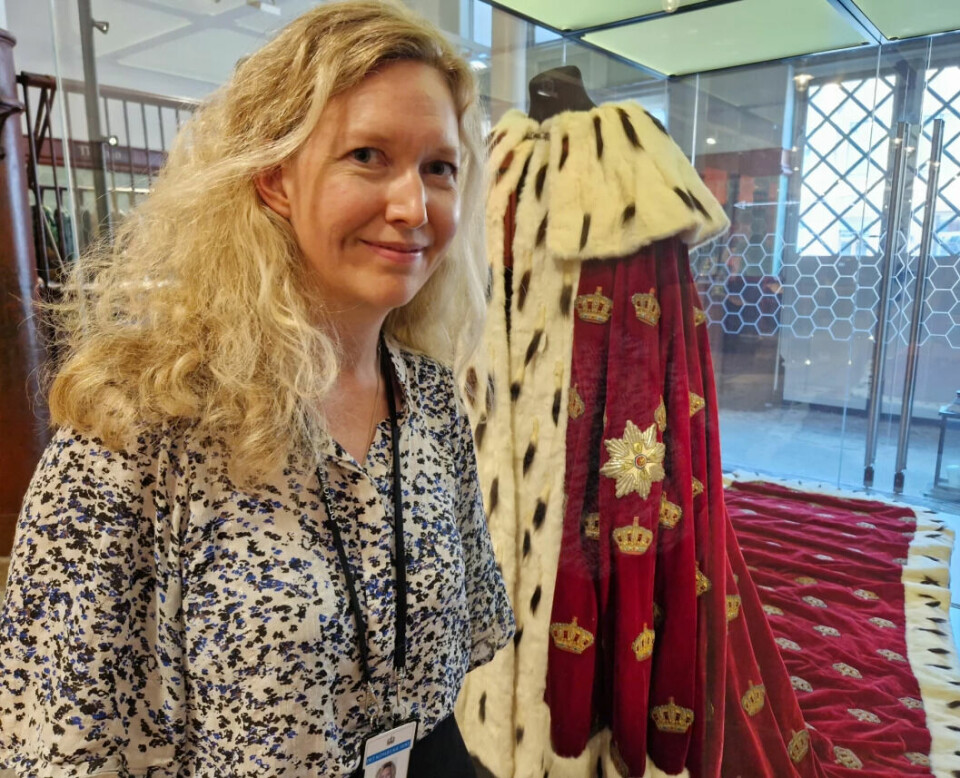
End of coronations
Only two years after the coronation of Haakon and Maud, the tradition ended. In 1908, the Storting decided to repeal the constitutional provision that Norway’s king should be crowned in Nidaros Cathedral.
“Norway was one of the last countries in Europe to stop coronations. It was considered undemocratic. But King Olav wanted a connection to the church and chose a consecration, as did King Harald and Queen Sonja,” Lorentzen says.
King Olav was consecrated in Nidaros Cathedral in 1958, but without the coronation robe and without his queen. Princess Märtha had passed away four years earlier. Harald and Sonja were consecrated in 1991.
“England is the only country that still practices coronations,” Lorentzen says.
Thus, Queen Maud became the last to wear the coronation robe.
During her coronation, Maud received a horse as a gift from her parents, King Edward VII and Queen Alexandra of Great Britain. It probably lived in the stable where the robe is now on display.
———
Translated by Alette Bjordal Gjellesvik.
Read the Norwegian version of this article on forskning.no
References:
Mindeblade fra Deres Majestæter Kong Oscars og Dronning Sofies kroninger i Stockholm og Throndhjem (Memories from the coronations of Their Majesties King Oscar and Queen Sophia in Stockholm and Trondheim). Waldm.Kriedt. 1873.
Riiber, A.M. ‘Dronning Sophie’ (Queen Sophia), Lutherstiftelsen, 1958.
































